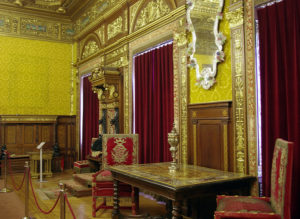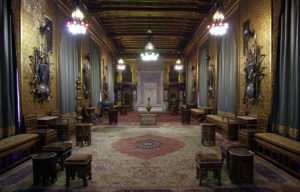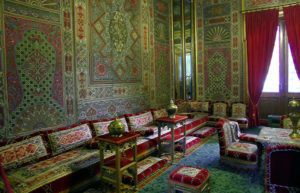King Karl of Romania built Peles Castle as a summer residence for his family in 1§873 and it was eventually completed in 1914, the year of his death. It remained a royal residence until 1947, when it was confiscated by the state. Ceaușescu wanted to use the Palace as his own private residence and began a complete restoration. Workers who didn’t like Ceaușescu told him there was a problem with a fungal infection throughout the palac, so he changed his mind and built a new residence in Sinaia. After the fall of Communism, the palace reverted to King Michael but is now run as a state museum.
At the time it was built it was state of the art. It was the first European castle to be lit by electricity. It also had central heating and a lift. It has over 160 rooms, each decorated in a completely different style. It contains one of the finest collections of art in Eastern and Central Europe, with statues, armour, paintings, furniture, gold, silver, stained glass, ivory, fine china, tapestries, and rugs
The castle has been described as one of the most stunning in Europe with its splendid German Neo-Renaissance architecture. It is a lovely setting on a wooded hillside overlooking the valley.
The castle is built round courtyards with wooden balconies and painted walls. In front is a terraced garden.
In the summer, all the government moved here, living in large houses built in the area. It became very much the second capital after Bucharest, especially during the First World War. The timber frame houses around the estate were used by the different members of the family.
The castle is open daily apart from Mondays and Tuesdays in the winter. It is a ten minute walk down through the trees from the square where there is parking. There is a 30 Lei charge for entry and another 35 Lei to take pictures. The castle does get very busy. There is a special entrance for foreign visitors, but this is closed on a Tuesday, when you join the long queue of Romanian visitors. There is a lot to take in and pressure to keep moving, so you don’t have a lot of time to stop and admire.
Entry is into the grand entrance hall with its heavy wood panelling, statues and beautiful marquetry ceiling.
A grand stair case leads up to the Hall of Honour where important guests were met. This is a very impressive room with walnut paneling on the walls and marquetry panels of different European castles.
Above is a stained glass roof.
A corridor lined with armour leads to the Weapons room. On the walls are displayed weapons from the C14th to C19th, including pieces captured from the Ottoman Turks.
Beyond is a small waiting room with heavy wood panelled walls, which leads into the library. The music room was used to host musical evenings organised by Queen Elizabeth. It has beautiful wood panelling on the walls with paintings above and a glorious wooden ceiling.
The Florentine room is completely different and is designed in the Italian Renaissance style and glows golden compared to the previous rooms. Although it looks like a throne room, it was never used as such.
Next to it is the mirror room with huge Venetian mirrors which took six months to arrive. Off this is the state dining room. Also in this area is the Moorish coffee room and the Turkish smoking room.
The visit ends in the Louis XIV style theatre.
This is an impressive castle but it does get very busy. Only small groups are allowed in at a time and there can be a long wait before being allowed in. Once inside there is pressure to keep moving. There is little information about the rooms and a lot depends on how much information the guide gives. Many of the rooms are very similar with heavy German panelling. The Florentine room, Moorish coffee room and the Turkish smoking room are completely different. We were on a tight time schedule so didn’t have time to wander round the outside of the castle or enjoy the grounds.
There are more pictures “here.”:http://wasleys.org.uk/eleanor/otherholidays/romania/day_nine/index.html
We visited as part of an eight day trip to Romania. My full report with all my pictures is “here.”:http://wasleys.org.uk/eleanor/otherholidays/romania/index.html










